Hi, I'm Florian Kohler, professional pool trick shot artist. And today, I want to talk about pattern play. In all of our previous PoolDawg lessons we have talked a lot about mathematical systems, like systematic aiming, and then shot-making on the balls, but this lesson is a little bit different. Pattern play and position do not get as much attention simply because most people like to find a perfect system, that miracle recipe, but really, pool is all about running out and finding the best way to run out. We’re going to cover the mental aspects and strategy of pattern play and how you're going to favor one side of the ball to another, and make your life easier by minimizing risk and improving your chances to run out.
Zone Play: Targeting Areas That Give the Best Chances to Run Out
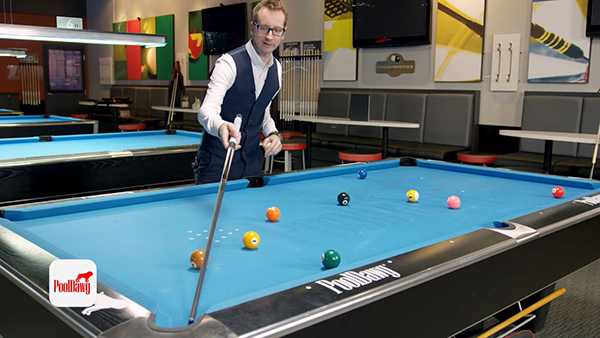
This first segment is all about zone play. So, we have a standard nine-ball layout here. Let's pretend my opponent breaks, scratches on the break, and I get ball in hand. You have to quickly identify which balls are easy to make in the correct order. So, we look at the one ball, obviously, first ball to make, it looks pretty okay. Looks likely it is going to go into that corner out there. Could go out there, but a little tougher to get positioned there so, this seems like the best option.
The two ball goes into the corner there, and that’s pretty much the only spot that it can go. The three ball goes into corner there. Same thing, I mean, those are pretty obvious choices. Now, with a ball in hand, the idea is to figure out where I could land this cue ball to make it as easy as possible for me to run those balls.
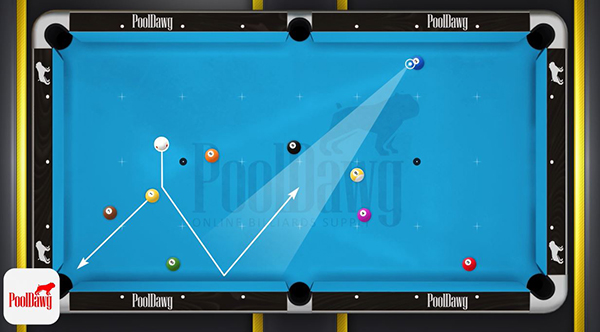
So, I'm going to look at positioning the cue ball here (see above) for a second. The easiest shot would be to set the cue ball somewhere there for the one in the corner, have our cue ball go somewhere there, and make the two ball.
However, if I look at the two ball, I'm going to look at the zone here. I have from the center of my two ball, here, to the edge of the eight, and there from the center of my two to the edge of the nine. This shape is triangular, so we call it a pie-shaped diagram. If I look at it, the most I have is a diamond width which is not much to work with. If I were to make that shot and play bad speed, I could get behind the eight. If I put a little too much left spin, I would get behind the nine. The incorrect choice can result in being out of position for the rest of the rack.
-Zone-to-land-the-cue-ball.jpg)
A lot of bad things can happen here. However, if I go into this zone now, I'm going to look at the two to the edge of the five. Then, I will look at the two to the rest of the table. You can see obviously, this pie-shaped diagram is much bigger than the previous one. There is a big difference. So, I probably have double chances to land in the correct zone, here, rather than if I was trying to land in the smaller zone. The shot might be more difficult because I have to put my cue ball somewhere there. However, the layout is so much easier this way.
It is an obvious choice; I have to go for the two in this zone. So, I'm going to show you now, I'm just going to shoot the one, one or two rail out there, to get in position for the two. There we go. So as you can see, I have no risk. I was never in danger, and now I'm on the two ball.
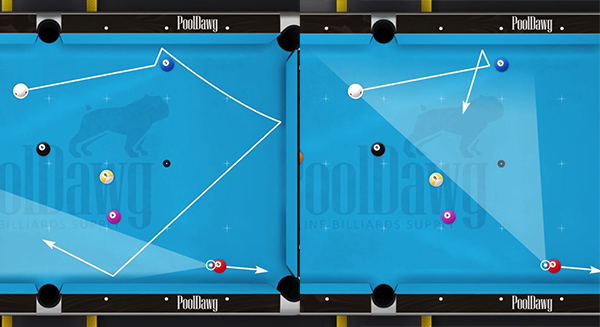
So, same thing for the two to three, the two goes in the corner. Now, I have two chances on the three ball, it seems like a very easy shot from there. Probably one that you can't miss, but you have to be exactly in this zone, which is again, maybe a diamond wide. And it's not quite the easy to get into good position. However, if I look from here, and draw a line from my three ball to the edge of the nine, I have room up to here because cutting that ball is not that difficult.
So, I almost have double the space in this zone compared to this zone. So really, what I need to do here is play a little stun, something like that, to get somewhere here. It doesn't have to be very precise. I know I'm going to be in the zone to make the three ball. And then, you continue to the four ball, and the five until you make the nine ball.
Angle of Approach: How to Get in the Zone
Following zone play is the angle of approach. In my opinion it's really its own important thing. So, we have set up here a standard eight-ball situation, so we're on the twelve so I'm going to have to make the 12 in the middle there, play position for the eight to win the game. So first, we're going to define what's our zone, what's our pie-shaped diagram. So, if I try to aim to make the eight in the corner, I can probably make it from here pretty easily up to, I'll say about there.
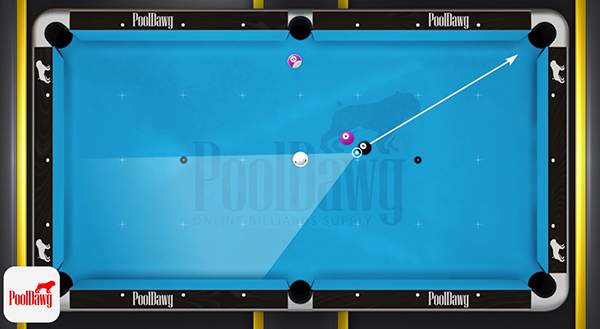
So, that's quite a big zone. Before I go any further, your pie diagram and your zone play are going to also depend on your ability to pot balls. That means if you're really good to pot cut shots, if you're really good to pot long shots, this might make your zone bigger and as you know, also the reverse thing. If you're not too comfortable with long shot and cut shot, this might be a little smaller. But that's going to be up to you. There's sort of a general area that is common sense, you just go in.
Now, with that being said, how do we get there from the 12 ball? Our 12 ball is an easy shot so we could approach this shot in a few different ways. I could hit the cue ball into the 12 with draw and try landing in the zone for the eight ball. The problem is, if you come across the zone, rather than into the zone, you're going to expose yourself to trouble. If we go from here to there, basically you can see the cue ball. I could hit the cue ball into the 12, and draw into that little zone. A lot of things can happen here.
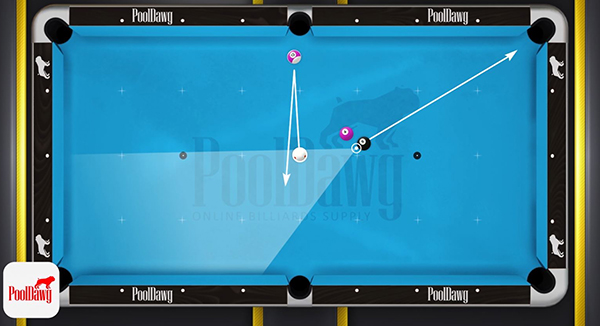
You could either overshoot it and pass the zone, or you could undershoot it. You’ll have an impressive cut shot that you might miss, and this is exactly where you could have some trouble. So, let's say you play follow. You hit the 12 in the side, twelve goes there, and cue ball goes here. You're probably going to end up in the bigger triangle, but again, you're coming across the zone rather than into the zone.
Speed is very important. If you hit it too hard, you might stay out. If you hit it too short, you might stay here. On top of that, you're a little further from the object ball so it doesn't seem like the right choice.
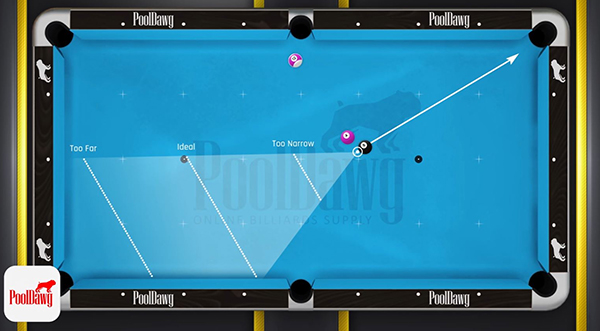
Now, the proper choice in this situation is to hit the 12, and go: long rail, short rail, or, the three rail here into the same pie shaped diagram. Now the thing is, you're entirely in the zone. That means as soon as you hit that first rail, and by the time you hit the second rail, you're stepping into the zone. That means, from the second to the third, you have about four diamonds to go there and you're still in the zone, meaning you're very safe. So, I'm just going to shoot that here, show you how to basically have the perfect position on the eight ball.
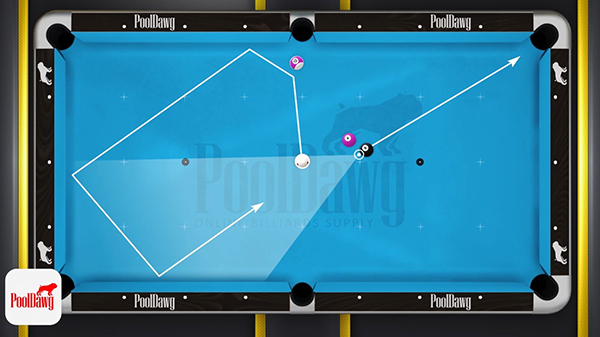
As you can see, from the second rail I was in the zone, from the third rail, I was in the zone. I shot it a little too slow, in my opinion. Here would have been better. I am still okay and I have no problem making that eight ball.
Second example in of our angle of approach segment is a typical nine-ball situation. Obviously, I'm on the eighth ball, I need to play position for the nine to make it in the corner there. So, again, we're going to find our zone to this corner here. It seems like the right zone. Now again, always pick the bigger zone. Some people would try to go here, but this is too risky. We have a much better chance to go out there. There are several ways to get there. You could go try two rails, or try go straight across. This is sort of dangerous because you come right across the zone, rather than into it.
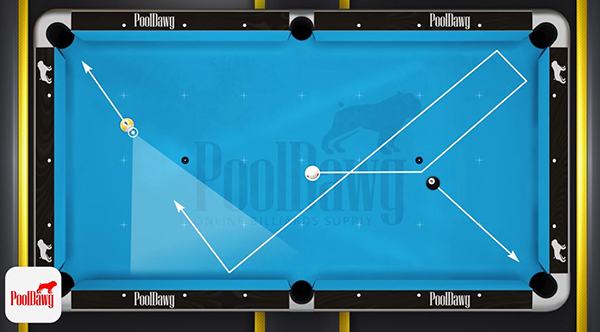
However, the good solution needs to go three rails. So, put the eight in the corner, go short, long, and land on the long and continue to stay on the big side of the zone. This will really improve your chances to of having good position on the nine ball. So, instead of just playing it carelessly, we're going to focus on getting closer to the corner out there. A little bit of spin helps you stay in the zone, and you're good to go for the nine ball. There you go. So as you can see, I shot it a little too hard still, but look at that! Because I came into that zone, and went all the way, my ball was still going and I still had the big zone out there. However, if would have chosen to go two rails, it would have been there, and I would probably be left with a very difficult shot. Meanwhile, here, I sort of have a hanger.
Here is quick tip for a 10-ball situation now. We’re on the seven, and if you play good position, we can either make the 10 ball in this corner, or in this corner. So, the logical thing would be to 1. Either play a small follow and try to play that 10 ball in this corner, or 2. Play a little draw then play the ten ball in this corner.
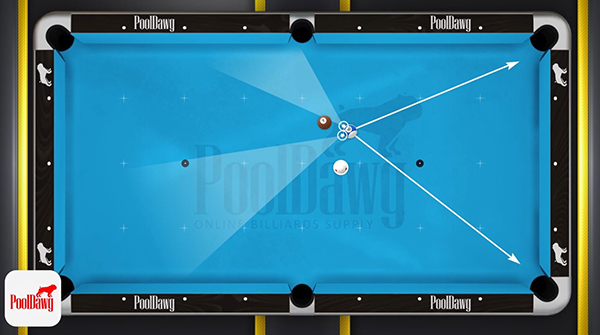
However, you can see it's a very sensitive shot. That means if you play a little too far, you're going to be out of shape and you're probably left with a pretty difficult shot. And again, the reason is because if you look at the zone, your pie shape would be something like this and this and you need to try to stay in that little corner. So, rather than trying for the small zone, you're going to try to go into the bigger zone.
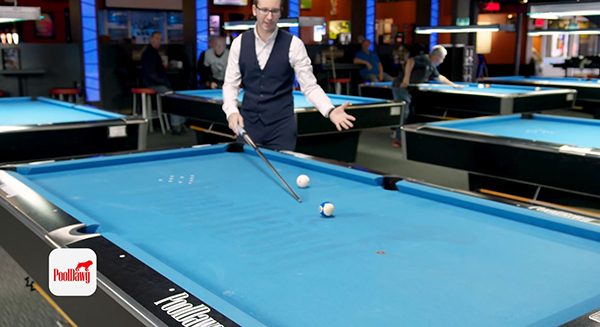
In this case, all we have to do is just go into the bigger zone somewhere out there and the shot is going to be easier, even though you have more distance. So, never hesitate to go away from the object ball, even though it seems harder. This is just the better choice. As you can see, I went away from it, but look at my angle now, it is much better. I could have landed here, or here, and it would still be ok. Now, I have a clear shot to the 10 ball in the corner out there for an easy end to the game.
Landing on the Correct Side of the Object Ball
The next part is about landing on the proper side of the object ball. This is part of position play because you always have to look ahead, and look for a way to get the odds of running out in your favor. Here, we have a typical nine-ball layout. We're going to illustrate this now, with the cue ball right there to the two ball. So obviously, the two ball is going to go in this corner, the three in this middle pocket and then I'm going to have to play position down there to make the four ball in the corner.
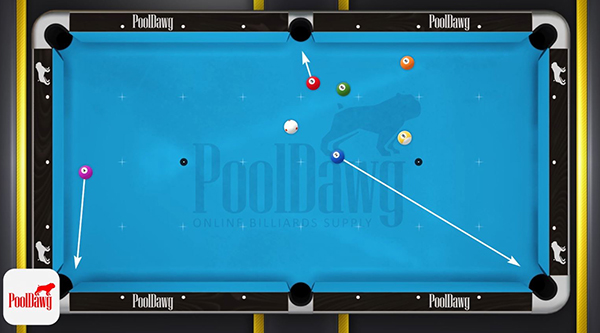
Most people, especially beginners, would just play a simple stop shot to make the two and then make the three. The problem is once you're there, you really can't do much because if I play my stop shot there, I'm going to have either difficult shot on the four or might be jacked up with the stick so I might be here. It's all very difficult. Now, what would work really well is if, instead, you just shot the cue ball into the two, make the two to same pocket but instead, just move it up this way, which would ensure that you make the three, and allow the cue ball to simply follow into the zone.
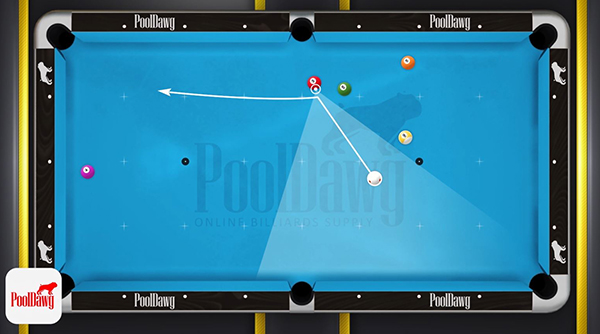
So really, you're really not making that much more of an effort but you're actually landing in the correct zone with a better chance at your next shot. If you look at your line to the three ball, you're going to have a good side and a bad side. Although if you take the pie diagrams, meaning you could make the three, it really is not the same because this side will not allow you to play position for the 4 ball. And that's what people say when, "I landed funny. I landed on the wrong side of the ball," this is exactly what it is. This is all the good side and this would be the bad side. What I'm going to do is I'm just going to shoot that for you, so we can illustrate the example. So as you can see, I really had a huge margin for error. It could have gone here, and it would have worked. If it went there, it would have worked. Let's just finish the three there and call it good.
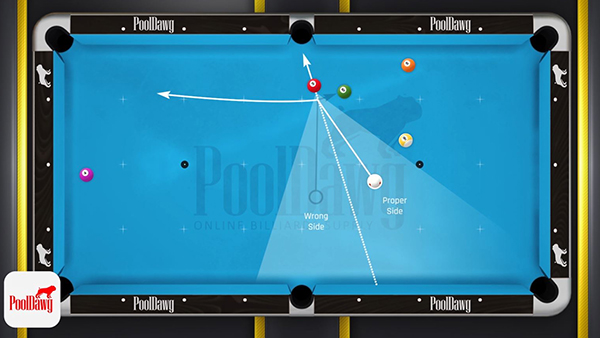
We're now going to cover a little bit of the mental and strategic aspect of pool, at least, in all the games that we've covered eight, nine and 10 ball. So, let's say you're playing eight ball. You're going to have a lot more balls on a table so that means a lot of clusters and a lot of problems to solve. So, if you're playing eight-ball, I like to use what we call an insurance ball. An insurance ball is a ball that you're always going to have on the table to help you out in case you get out of position, or in case you miss a chance to open a cluster. You will still have that ball to just put you out and give you another chance.
Now, the same goes for nine-ball. Your layout is not going to be wide-open every time, and you can’t always run out. So, you're going to have to find a way to open your problem. In nine-ball especially, you have to open your problems early, as early as possible, because if you wait too long, you might get in trouble and you might run out of options. And usually, that's how you lose the game. This is available in pretty much every game you're playing. Meanwhile, the insurance ball is more for eight-ball.
The next thing I want to talk about is the player you're playing, because you're not only playing the table. That's sort of a legend that is going around in pool. You're actually playing the players as well. Let's say you're playing a runout player, so all those players at the top level, they're pretty much all run-out players. But for a mere mortal, it's a little bit different. If you're playing a runout player, you know that if you're trying to open that trouble ball early, you might get in trouble because if you miss and you make it wide open, that guy [or gal] is just going to run out on you. So, maybe it's better for you to just simply make a ball, play a safety, and kind of just sweat it out and see if you can win the safety battle.
Now, the opposite goes as well. If you're playing what we call a grinder, somebody that just makes one or two balls, and then doesn't like it, and just kind of leaves a safety (and you know he's a strong safety player). Well, you might do the reverse thing. You might try to open your problem right away, leave the table wide open and hope he doesn’t run out. So, never underestimate that aspect of the game. Always look to open your problem early. If you have insurance ball, take it and then analyze the player you're playing as much as the table.
Running Out
I just broke a rack of eight-ball. I made the 13 ball and left my cue ball somewhere pretty good in the middle and this is what I'm left with. So, we're going to kind of work backward. Now remember, working backward only works in eight-ball, and not in nine-ball. In nine ball, you need to follow the numbers so you don't really have much of a choice. In this case, we have a choice in the order in the balls we select. Step one is selecting the right category of balls. I'm looking right there, I see a bunch of solids here all together in a bad spot so this is definitely a no-go. This is something you want to avoid if you can. Looking further into the solids, those two are also kind of funny where they are. I don't like them.
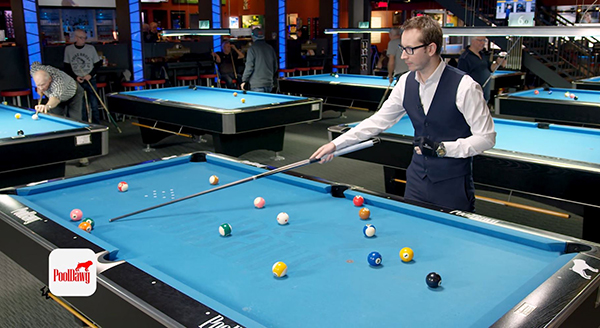
So now, we know we're going to select the striped balls. Step number two is to find out which ones are our key balls. Our key balls to get to the eight ball would be the 10 and the nine balls. They're literally on the same line here. So, either one of them would work because I could make the eight in this corner or the eight in this corner. That's done. Now, we have to figure out the correct way to run this out. Usually you try to avoid is go back and forth, back and forth. This one is pretty bad, so if you divide the table in two halves, and try to work in one half of the table, then go down into the second half, it will make your work a lot easier. So in this case, I’ve pretty much figured out my solution. All I have to do is run them out, and I'm going to start with the 14, then follow with the 12 and keep going from there.
Okay, everyone. This is pretty much it's for pattern play. I know there was a lot of information and some stuff seems a little vague, but really it's more of a feel thing, it's something you have to practice. It's something you have to visualize, and since everybody's a little different, there's always so much you can talk about it. But never underestimate the tactical aspect of the game, It's what's will make you a winner in some situations. As usual, please comment below, any question, we'll try to answer the best we can. And for all your pool and billiard supplies, please go check out pooldawg.com. Link is in description. See you guys.
- RELATED ARTICLES
- How To Up Your Game: Pattern Play and Safeties – By Florian Kohler
- Run Out Practice – By Mikey Verkruyse
- Taking Shape at the Table – By Mark Finkelstein